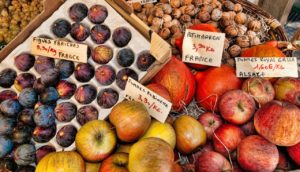La Toussaint: An Important French Family Holiday with a Special Treat: Les Niflettes
La Toussaint, or All Saints’ Day, falls on November 1st every year. Students and adults usually have days or weeks off, so this is a time for families to enjoy spending time together. Many families honor their loved ones who have passed away. This holiday, deeply rooted in Catholic tradition, is a time of reflection, remembrance, and a way to pay respect to the deceased. La Toussaint is observed across France, with many people visiting cemeteries to clean graves, light candles, and adorn headstones with flowers. Chrysanthemums, symbols of memory and eternity, are the typical flower of La Toussaint. There’s also a special food associated with the holidays, called les niflettes de La Toussaint. In this post we’ll learn a little bit about how people in France celebrate the holiday. We’ll also learn some of the history of the Toussaint pastries, niflettes. If you enjoy baking, you’ll even find a recipe for niflettes that you can try!
“Tous (les) saints”
La Toussaint (from Tous saints), All Saints’ Day in English, falls on November 1st. It is un jour férié important (a major holiday) in France, celebrating the communion of saints, past and present. The holiday reminds observant people to strive for la sainteté (sainthood). For less religious people, La Toussaint is more of a secular holiday, when people enjoy time off from work or school – two full weeks! – and get together with family. You can think of La Toussaint as a kind of midterm break between the summer and the Christmas holidays.
Unlike Halloween, which falls the day before and involves costumes and festive gatherings, the day of La Toussaint has a quiet, solemn tone. Although many French people are now non-croyants (non-believers), those who are practicing Catholics may light des lampions (paper lanterns) or des cierges (church candles) in churches and cemeteries. Cemeteries become places of gathering, where family members come together to share memories of those who have passed. Des chrysanthèmes (chrysanthemums) are particularly popular on this holiday due to their long-lasting blooms and vibrant colors. Markets across the country are full of these flowers, especially in hues of yellow, white, and purple. People also leave them on les tombes (the graves) of passed loved ones, which transforms graveyards into poignant displays of love and memory.
Niflettes: little traditional cakes for la Toussaint
There is a special pastry associated with the holiday, known as niflettes. These are are small cakes or cookies, made of pâte feuilletée (puff pastry) filled with a vanilla and orange flavored cream.
Niflettes originated in the city of Provins in Seine-et-Marne, just a bit east of Paris. They date back to the Middle Ages, and according to one legend, people gave this little treats to orphans on All Souls Day, telling them “ne flete,” (ne pleure pas, don’t cry), hence the name. According to another legend, the name niflettes comes from bakers from La Picardie (Picardy) who walked the streets of Provins called out Niflez, niflez ! (Sentez, sentez ! Smell, smell! in Picard, the regional French of Picardy.) Whatever the true history of the word is, niflettes are very much associated with La Toussaint today.
If you’d like to try your hand at making your own niflettes, here is une recette très simple (a very simple recipe):
- 1 roll of puff pastry
- 4 oz of milk
- 1 egg yolk
- 1 oz sugar
- 1 T. flour
- Vanilla extract
- Confectioner’s sugar
Heat the milk. Whip the egg yolk with the sugar and a few drops of vanilla extract. Add the flour, mix well, and add the hot milk. Then pour the mixture into a saucepan, and thicken over low heat, stirring constantly. The cream will be ready when it becomes shiny. Put the cream in a container, let it cool and put in the fridge. Using a cookie cutter or a small glass, cut the puff pastry into 2.5″ to 3″ diameter rounds. On a sheet of baking paper, put two discs on top of each other and press in the center to form a hollow. Brush with egg yolk, then drop a teaspoon of the custard cream into each.
Preheat your oven to 180° C (350° F). Bake for about 20 minutes. Take out the niflettes, and sprinkle with confectioner’s sugar before enjoying them warm.
Learn French with the Language Garage!
We hope you’ve enjoyed learning about La Toussaint and les Niflettes. If you’d like to learn more, check out our other posts on French language, culture, and more. And if you’re looking for convenient and affordable live French lessons with a real teacher, check out The Language Garage. Our lessons are given online in a virtual classroom, so it doesn’t matter where you live or work. We can come to you. And we have flexible options, with a free trial so that you can decide if there’s a fit. Check us out!






